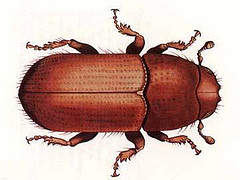Pine Bark Beetles
Three species of pine bark beetles-ips beetles, black turpentine beetles, and southern pine beetles-destroy significant numbers of North Carolina's extensive pine tree population each year. Of these pests, the southern pine beetle, characterized by a short, dark reddish brown winged body, is the most serious threat to North Carolina pines. These beetles breed in all species of yellow, white, red, and spruce pines, preferring shortleaf, loblolly, Virginia, and pitch pines. Southern pine beetles will attack healthy trees and can kill several hundred acres during a single outbreak. Affected trees are characterized by browned tree crowns and S-shaped galleries under the bark. Southern pine beetle infestation usually kills trees by attracting a blue stain fungus that weakens the connective tissue of the tree and renders it useless for timber. Each year, southern pine beetles destroy North Carolina timber worth hundreds of millions of dollars; good forestry management practices are the best defense against all three varieties, as weak or damaged trees are always attractive hosts.
References:
James A. Beal and Calvin L. Massey, Bark Beetles and Ambrosia Beetles (Coleoptera: Scolytoidea): With Special Reference to Species Occurring in North Carolina (1945).
Eric Day, "Bark Beetles," Virginia Cooperative Extension Publication No. 444-216 (1996).
Image Credit:
Southern Pine Beetle. Image courtesy of U.S. Department of Agriculture. Available from https://www.flickr.com/photos/usdagov/6347142479/ (accessed August 22, 2012).
1 January 2006 | Smith, Lisa D.
